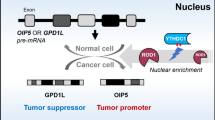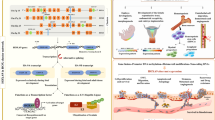Abstract
Brn-3a, a member of the POU gene family (so-called because of the similarity with the group of transcription factors Pit, Oct, and Unc), was found in neuronal cells engaged in the transcription activity of the p1 and p2 promoters of the most powerful antiapoptotic gene, namely, Bcl-2. The alternative splicing of Brn-3a mRNA produces two molecular forms: a longer, Bcl-2 transactivating form, and a shorter inactive form, lacking 84 AA in the aminoterminus. In neuronal cells, following Brn-3a gene transfection and superexpression, an increase of 30 fold of the Bcl-2 protein occurs, leading to apoptosis protection.
However, recent works demonstrate that Brn-3a expression is not restricted to neuronal cells, as its activity was detected also in cancer cells of non-neuronal nature.
Looking for mechanisms linking Brn-3a to carcinogenesis, we discuss the role of this transcription factor in influencing Bcl-2/p53 antagonism and Bcl-2/VEGF induction of tumor angiogenesis, concluding this review with a proposal for the oncogenic nature of Brn-3a.
Similar content being viewed by others
References
Agarwal, M.L., Taylor, W.R., Chernov, M.V., Chernova, O.B., and Stark, G.R. (1998) The p53 network. J. Biol. Chem. 273, 1–4.
Levine, A.J. (1997) p53, the cellular gatekeeper for growth and division. Cell 88, 323–331.
Slee, E.A., Harte, M.T., Kluck, R.M., et al. (1999) Ordering the cytochrome c-initiated caspase cascade: hierarchical activation of caspases-2, -3, -6, -7, -8, and-10 in a caspase-9-dependent manner. J. Cell Biol. 144, 281–292.
Cecconi, F., Alvarez-Bolado, G., Meyer, B.I., Roth, K.A., and Gruss, P. (1998) Apaf1 (CED-4 homolog) regulates programmed cell death in mammalian development. Cell 94, 727–737.
Adams, J.M. and Cory, S. (1998) The Bcl-2 protein family: arbiters of cell survival. Science 281, 1322–1326.
Korsmeyer, S.J. (1992) Bcl-2 initiates a new category of oncogenes: regulators of cell death. Blood 80, 879–886.
Tsujimoto, Y. (1998) Role of Bcl-2 family proteins in apoptosis: apoptosomes or mitochondria? Genes Cells 3, 697–707
Reed, J.C. (1994) Bcl-2 and the regulation of programmed cell death. J. Cell Biol. 124, 1–6.
Lee, W.Y., Jin, Y.T., and Tzeng, C.C. Reciprocal expression of Bcl-2 and p53 in breast ductal carcinoma. (1996) Anticancer Res. 16, 3007–3012.
Hoehner, J.C., Gestblom, C., Olsen, L., and Pahlman, S. (1997) Spatial association of apoptosis-related gene expression and cellular death in clinical neuroblastoma. Br. J. Cancer 75, 1185–1186.
Miyashita, T., Krajewski, S., Krajewska, M., et al. (1994) Tumor suppressor p53 is a regulator of Bcl-2 and bax gene expression in vitro and in vivo. Oncogene 9, 1799–1805.
Miyashita, T., Harigai, M., Hanada, M., and Reed, J.C. (1994b) Identification of a p53-dependent negative response element in the Bcl-2 gene. Cancer Res. 54, 3131–3135.
Latchman, D.S. (1998) The Brn-3a transcription factor. Int. J. Biochem. Cell Biol. 30, 1153–1157.
Budhram-Mahadeo, V., Morris, P..J, Smith, M.D., Midgley, C.A., Boxer, L.M., and Latchman D.S. (1999) p53 suppresses the activation of the Bcl-2 promoter by the Brn-3a POU family transcription factor. J. Biol. Chem. 274, 15237–15244.
Smith, M.D., Ensor, E.A., Coffin, R.S., Boxer, L.M., and Latchman, D.S. (1998) Bcl-2 transcription from the proximal P2 promoter is activated in neuronal cells by the Brn-3a POU family transcription factor. J. Biol. Chem. 273, 16715–16722.
Ndisang, D., Budhram-Mahadeo, V., and Latchman, D.S. (1999) The Brn-3a transcription factor plays a critical role in regulating human papilloma virus gene expression and determining the growth characteristics of cervical cancer cells. J. Biol. Chem. 274, 28521–28527.
Theil, T., McLean-Hunter, S., Zornig, M., and Moroy, T. (1993) Mouse Brn-3 family of POU transcription factors: a new aminoterminal domain is crucial for the oncogenic activity of Brn-3a. Nucleic Acids. Res. 21, 5921–5929
Leblond-Francillard, M., Picon, A., Bertagna, X., and de Keyzer, Y. (1997) High expression of the POU factor Brn3a in aggressive neuroendocrine tumors. J. Clin. Endocrinol. Metab. 82, 89–94.
Xie, B., Tam, N.N., Tsao, S.W., and Wong, Y.C. (1999) Co-expression of vascular endothelial growth factor (VEGF) and its receptors (flk-1 and flt-1) in hormone-induced mammary cancer in the Noble rat. Br. J. Cancer 81, 1335–1343.
Lane, D.P. (1994) The regulation of p53 function: Steiner Award Lecture. Int. J. Cancer 57, 623–627.
Folkman, J. (1995) Angiogenesis in cancer, vascular, rheumatoid and other disease. Nat. Med. 1, 27–31.
Korpelainen, E.I., and Alitalo, K. (1998) Signaling angiogenesis and lymphangiogenesis. Curr. Opin. Cell Biol. 10, 159–164.
Biroccio, A., Candiloro, A., Mottolese, M., et al. (2000) Bcl-2 overexpression and hypoxia synergistically act to modulate vascular endothelial growth factor expression and in vivo angiogenesis in a breast carcinoma line. FASEB J. 14, 652–660.
Gerber, H.P., Dixit, V., and Ferrara, N. (1998) Vascular endothelial growth factor induces expression of the antiapoptotic proteins Bcl-2 and A1 in vascular endothelial cells. J. Biol. Chem. 273, 13313–13316.
Nor, J.E., Christensen, J., Mooney, D.J., and Polverini, P.J. (1999) Vascular endothelial growth factor (VEGF)-mediated angiogenesis is associated with enhanced endothelial cell survival and induction of Bcl-2 expression. Am. J. Pathol. 154, 375–384.
Gay, R.D., Dawson, S.J., Murphy, W.J., Russell, S.W., and Latchman, D.S. (1998) Activation of the iNOS gene promoter by Brn-3 POU family transcription factors is dependent upon the octamer motif in the promoter. Biochim. Biophys. Acta 1443, 315–322.
Chiarugi, V., Magnelli, L., and Gallo, O. (1998) Cox-2, iNOS and p53 as play-makers of tumor angiogenesis. Int. J. Mol. Med. 2, 715–719.
Pal, S., Datta, K., and Mukhopadhyay, D. (2001) Central role of p53 on regulation of vascular permeability factor/vascular endothelial growth factor (VPF/VEGF) expression in mammary carcinoma. Cancer Res. 61, 6952–6957.
Holash, J., Wiegand, S.J., and Yancopoulos, G.D. (1999) New model of tumor angiogenesis: dynamic balance between vessel regression and growth mediated by angiopoietins and VEGF. Oncogene 18, 5356–5362.
Parenti, A., Morbidelli, L., Cui, X.L., et al. (1998) Nitric oxide is an upstream signal of vascular endothelial growth factor-induced extracellular signal-regulated kinase1/2 activation in postcapillary endothelium. J. Biol. Chem. 273, 4220–4226.
Author information
Authors and Affiliations
Rights and permissions
About this article
Cite this article
Chiarugi, V., Del Rosso, M. & Magnelli, L. Brn-3a, a neuronal transcription factor of the POU gene family: Indications for its involvement in cancer and angiogenesis. Mol Biotechnol 22, 123–127 (2002). https://doi.org/10.1385/MB:22:2:123
Issue Date:
DOI: https://doi.org/10.1385/MB:22:2:123




